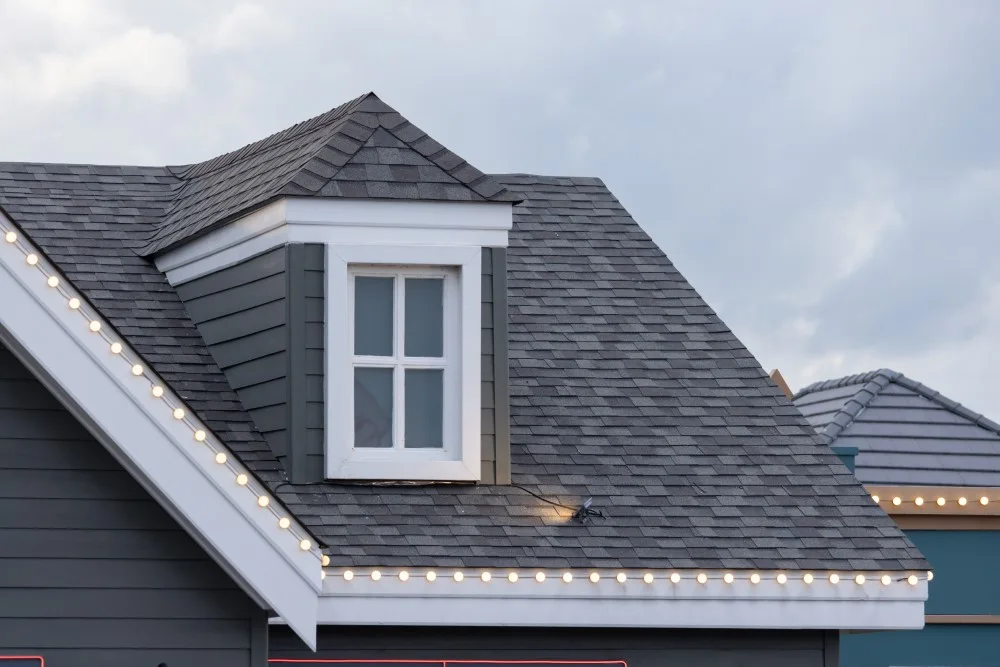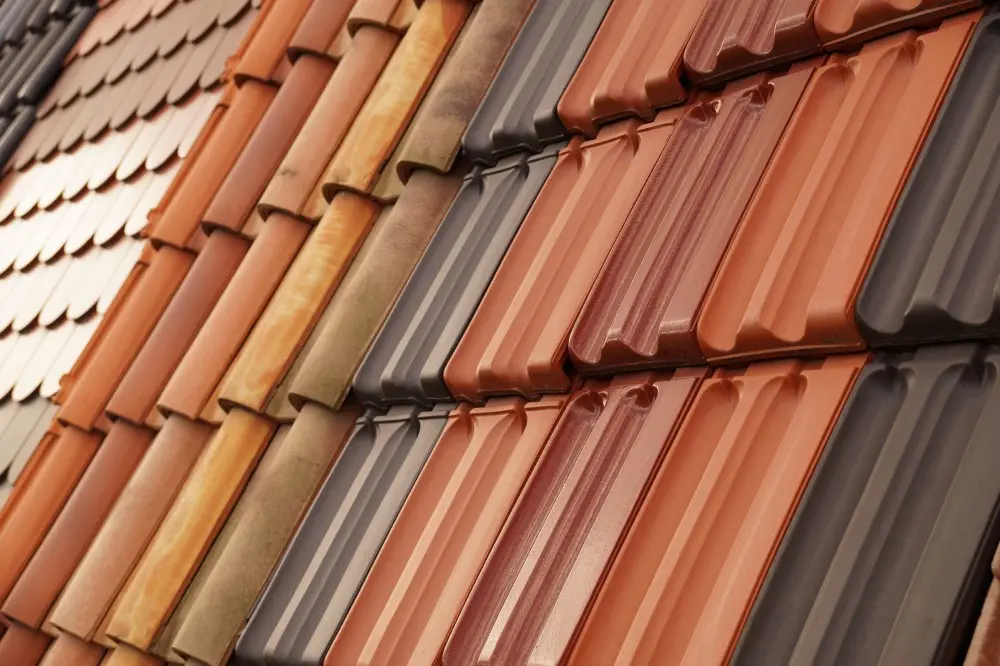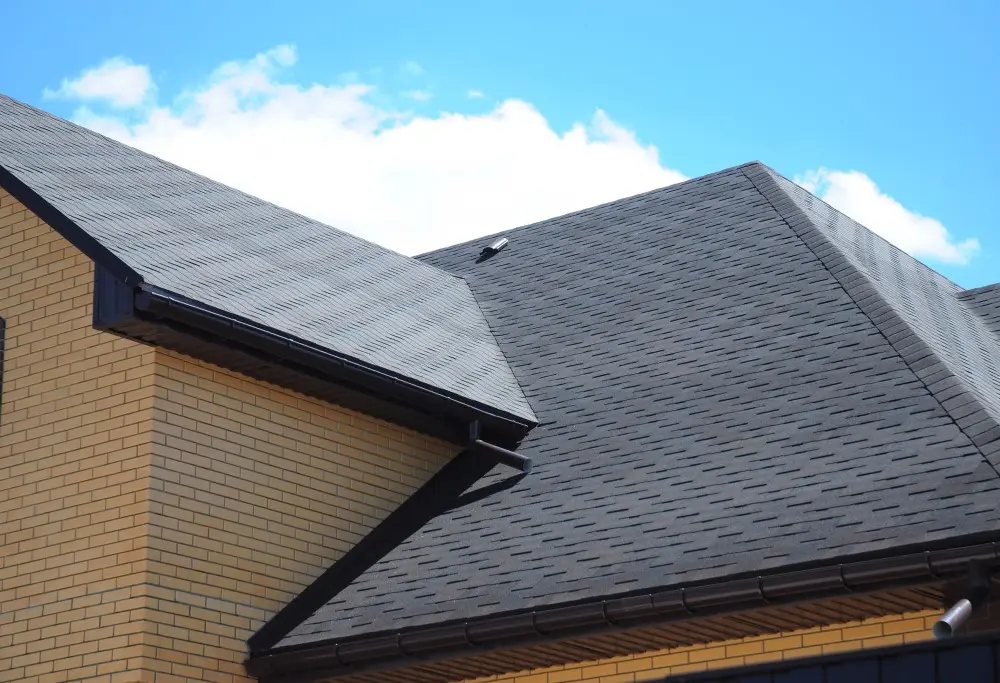The Most Common Roofing Materials
The roofing industry offers dozens of material choices, but four roofing types dominate residential roofing projects across America. Each brings specific advantages for different homes, climates, and budgets.
1. Asphalt Shingles
Asphalt shingles remain the most popular roofing material in the United States, covering about 75% of American homes. They come in three main types: 3-tab shingles (flat, affordable, basic), architectural shingles (dimensional, durable, stylish), and luxury shingles (high-end, slate-like, long-lasting). Costs range from $3–$7 per square foot installed, offering options for both budget-conscious and premium-seeking homeowners.
- Life expectancy: 15-30 years, depending on quality and regular maintenance.
- Weather resistance: Handles winds up to 130 mph with proper installation.
- Energy efficiency: Dark colors absorb heat, though reflective coatings can reduce energy costs.
2. Metal Roofing
Metal roofs have transformed from purely industrial buildings to mainstream residential choices. A standing seam metal roof costs anywhere from $10 to $15 per square foot; although it’s more expensive, it delivers 40 to 70 years of protection. Metal shingles cost slightly less, at $7 to $12 per square foot. Homeowners have choices, including galvanized steel, aluminum shingles, copper roofing, and stone-coated steel.
- Durability: Withstands harsh weather conditions, including hail and high winds.
- Maintenance requirements: Minimal maintenance beyond annual inspections.
- Energy savings: Reflects heat to cut cooling bills by 10-25% in hot climates.
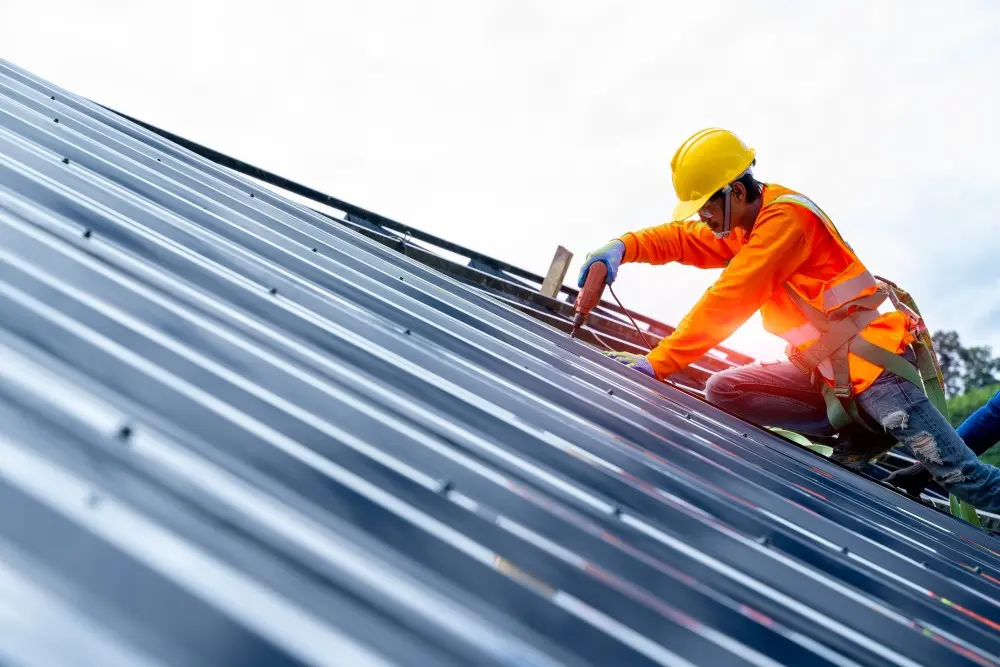
3. Wood Shingles and Shakes
Natural wood shingles bring warmth and character that composite shingles can't match. Cedar remains the top choice for wood roofing, though redwood and pine also appear in certain regions. Installation costs range from $6 to $10 per square foot. The difference between shingles and shakes comes down to manufacturing: shingles are sawn smooth, while shakes are split for a rougher texture.
- Thermal insulation: Natural wood provides superior insulation compared to other roofing materials.
- Environmental impact: Biodegradable raw materials from renewable forests.
- Fire safety: Requires fire-resistant treatments in many jurisdictions.
4. Slate Roofing
Looking to buy the longest-lasting roof system money can buy? Natural slate is the answer. Slate tiles cost $10 to $30 per square foot installed, placing them among the priciest roofing options. Yet slate roofs routinely last 75 to 200 years, making the higher cost worthwhile for historic properties and luxury homes. Synthetic slate offers similar aesthetics at half the price.
- Weight considerations: Slate shingles weigh 800-1,500 pounds per square, requiring a reinforced roof structure.
- Weather performance: Completely fire-resistant and handles severe weather conditions.
- Investment return: Adds significant property value to upscale homes.
#cta_here
Tile Roofing Options
Tile roofing brings Mediterranean flair to American neighborhoods while providing exceptional material longevity. When properly installed, both clay and concrete versions protect homes for generations.
5. Clay Tiles
Clay tiles have protected buildings for thousands of years, and modern versions continue that tradition. A clay tile roof costs $10 to $20 per square foot installed. These traditional materials come in Spanish barrel styles, flat French profiles, and interlocking designs. Each tile gets its permanent color during the manufacturing process.
Climate performance: Naturally regulates temperature in both hot and cold weather.
- Color retention: Never needs painting since the color runs throughout the clay.
- Longevity: Properly installed clay tiles last 50 to 100 years.
6. Concrete Tiles
Concrete tiles deliver clay's aesthetics at lower prices. A concrete tile roof runs $7 to $12 per square foot installed. Manufacturers mold concrete into profiles that mimic natural wood, slate tiles, or traditional clay. Modern concrete incorporates fiber reinforcement for improved impact resistance.
- Design variety: Available in countless shapes, textures, and colors.
- Weight: Lighter than clay, but still needs adequate structural support.
- Maintenance: Requires occasional repairs of cracked or chipped tiles.

Flat and Low-Slope Solutions
Flat roofs and low-sloped roofs need specialized materials that can handle things like standing water and extreme temperatures. These roofing systems protect everything from modern homes to commercial buildings.
7. Built-Up Roofing (BUR)
Built-up roofing layers consist of multiple sheets of roofing felt with hot tar or asphalt between each ply. This time-tested approach costs $5 to $10 per square foot installed. The final surface gets either gravel ballast or a reflective coating. BUR systems work well for low-slope roofs where water drainage moves slowly.
- Redundancy: Multiple layers provide backup protection if one layer fails.
- Proven track record: Over 100 years of successful installations.
- Repair simplicity: Damaged sections patch easily without full replacement.
8. TPO Membrane Roofing
TPO roofs are the fastest-growing segment of commercial membrane roofing. This single-ply membrane roof costs $4 to $8 per square foot installed. Heat-welded seams create watertight connections stronger than the membrane itself. White TPO reflects sunlight to reduce cooling demands.
- Installation speed: Large rolls cover quickly to minimize labor costs.
- Chemical resistance: Handles oils, fats, and many industrial chemicals.
- Flexibility: Accommodates building movement without cracking.
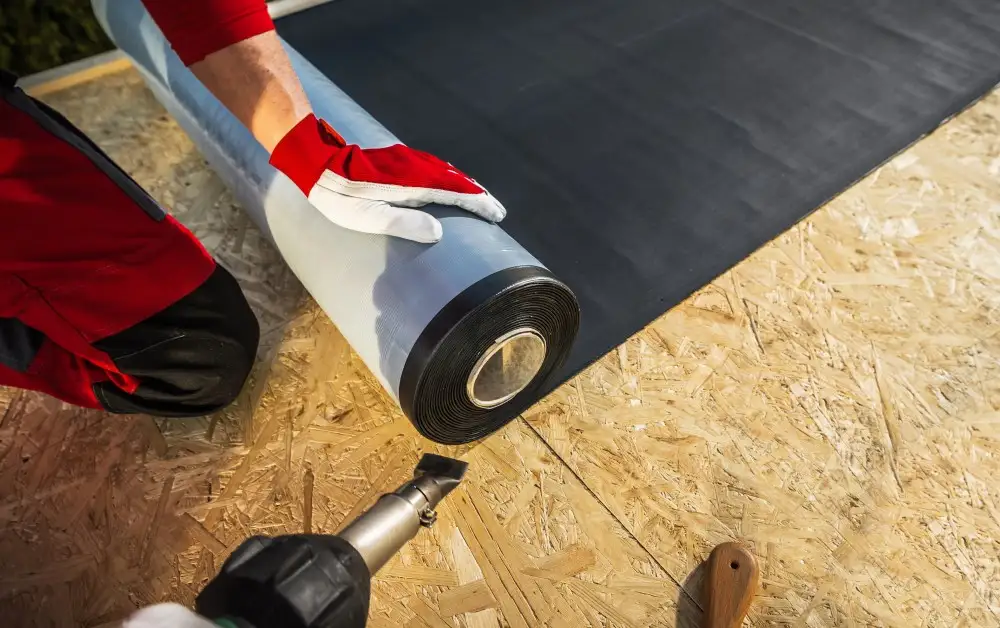
9. EPDM Rubber Roofing
EPDM creates a rubber roof from synthetic rubber compounds, and installation runs $4 to $7 per square foot. This membrane roofing suits both residential and commercial flat roofs. Black EPDM absorbs heat, while white versions reflect it.
- Longevity: Properly installed EPDM lasts 25 to 30 years.
- Weather resistance: Handles temperature extremes from -40°F to 300°F.
- Repair ease: Patches adhere easily to existing membranes.
Alternative and Eco-Friendly Options
You don’t need to compromise on performance, even if you’re interested in eco-friendly roofing. Innovative roofing materials address environmental concerns while solving specific roofing challenges. These alternatives range from ultra-budget rolled roofing to elaborate green roofs.
10. Green Roofs and Living Systems
Green roofs support plant life that provides thermal insulation and manages stormwater runoff. Living roofs cost $15 to $30 per square foot, but the benefits are unique. An interesting fact is that cities increasingly require green roofing on large commercial projects to combat heat islands.
- Environmental benefits: Filters air, reduces runoff, and creates habitat.
- Energy performance: Plants and soil provide exceptional insulation.
- Structural needs: Requires waterproofing plus 20-80 pounds per square foot capacity.
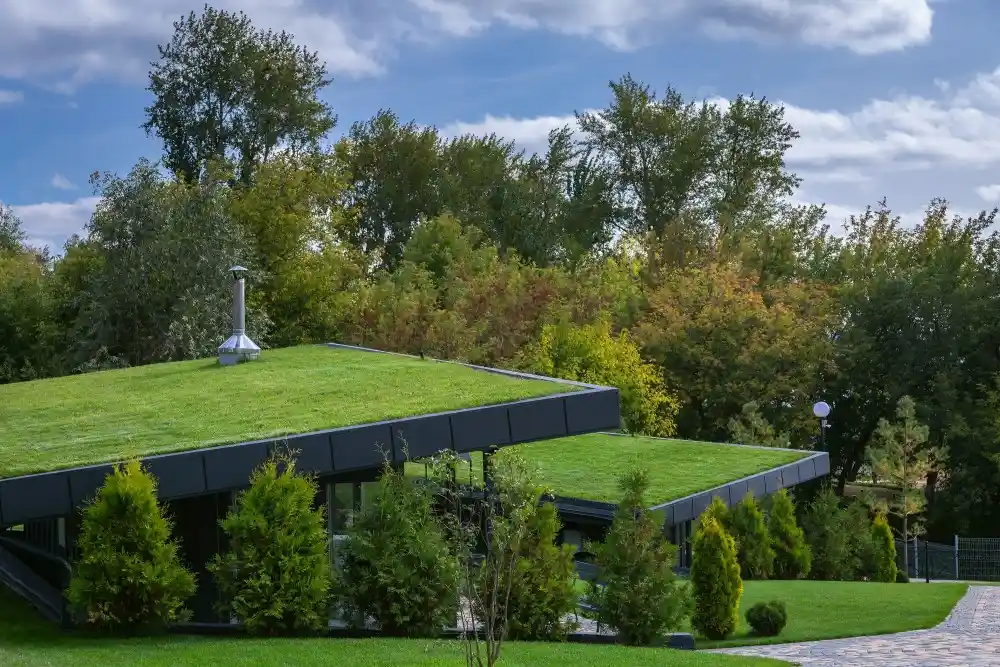
11. Recycled Rubber Shingles
Rubber shingles made from recycled tires cost $4-$8 per square foot installed. These eco-friendly roofing choices look surprisingly similar to slate roofs or wood shingles. Recycled materials divert waste from landfills while creating durable roofing products.
- Impact resistance: Bounces back from hail without damage.
- Installation: Cuts with standard tools and installs like traditional shingles.
- Warranty coverage: Many manufacturers offer 30- to 50-year warranties.
12. Rolled Roofing
Rolled roofing provides bare-bones protection for $2 to $4 per square foot installed. This material works for sheds, garages, and temporary coverage during roofing projects. While it only lasts 5-10 years, rolled roofing is an affordable way to address immediate problems.
- Emergency repairs: Quickly cover damaged sections until proper repairs can be made.
- Slope requirements: Works on roofs as flat as 1:12 pitch.
- Best uses: Temporary structures and utility buildings.
How to Choose the Right Roofing Material for Your Home
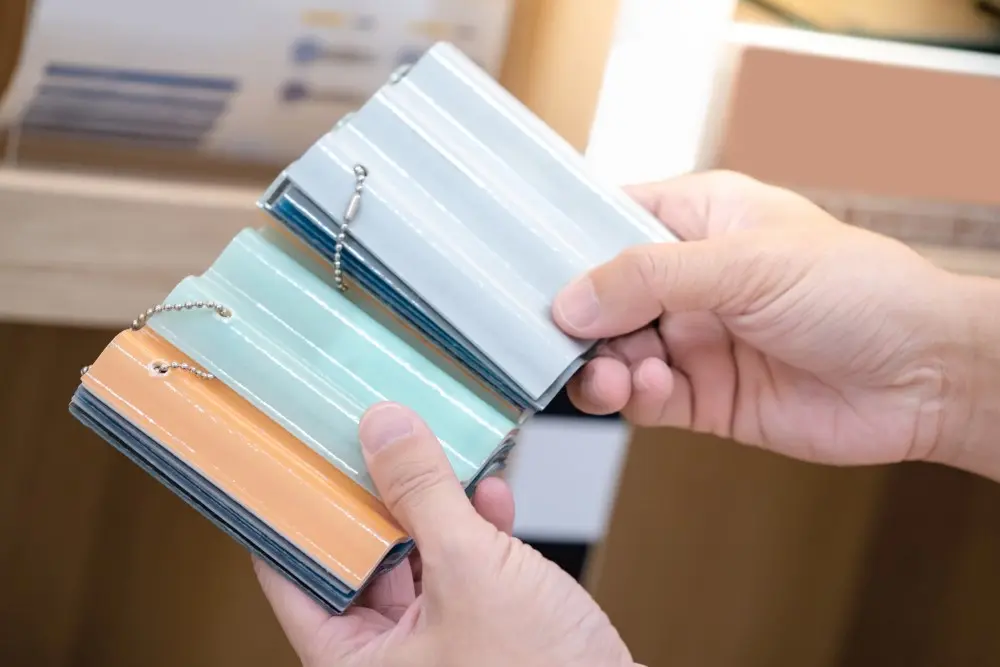
You must balance multiple factors when selecting the ideal roofing material for your home. This isn’t a choice you’ll want to take lightly, as it affects everything from monthly utility bills to how long your roof lasts.
Climate Considerations
Your local weather patterns strongly influence which roof materials perform best. Areas with frequent hailstorms benefit from impact-resistant options such as metal roofs or rubber shingles. Regions experiencing temperature swings need materials that expand and contract without cracking. For example, Middle Tennessee's hot summers and occasional ice storms favor metal roofing or quality architectural shingles over more rigid materials.
Budget Planning
The initial roof cost tells only part of the story. Three-tab shingles might save money upfront, but need replacement twice as often as metal roofs. Calculate total ownership costs, including installation, energy savings, maintenance, and eventual replacement. For example, a $15,000 metal roof that lasts 50 years costs less annually than a $7,000 asphalt shingle roof needing replacement every 20 years.
Home Value Impact
Don’t be afraid to invest in your roof. According to the 2025 JLC Cost vs Value Report, roof replacement consistently ranks among home improvements with strong returns. Metal roofing recoups about 50% of its cost at resale, while asphalt shingle replacement returns approximately 68%. Premium materials boost curb appeal and attract buyers willing to pay more for low-maintenance, long-lasting roofing systems.
Structural Requirements
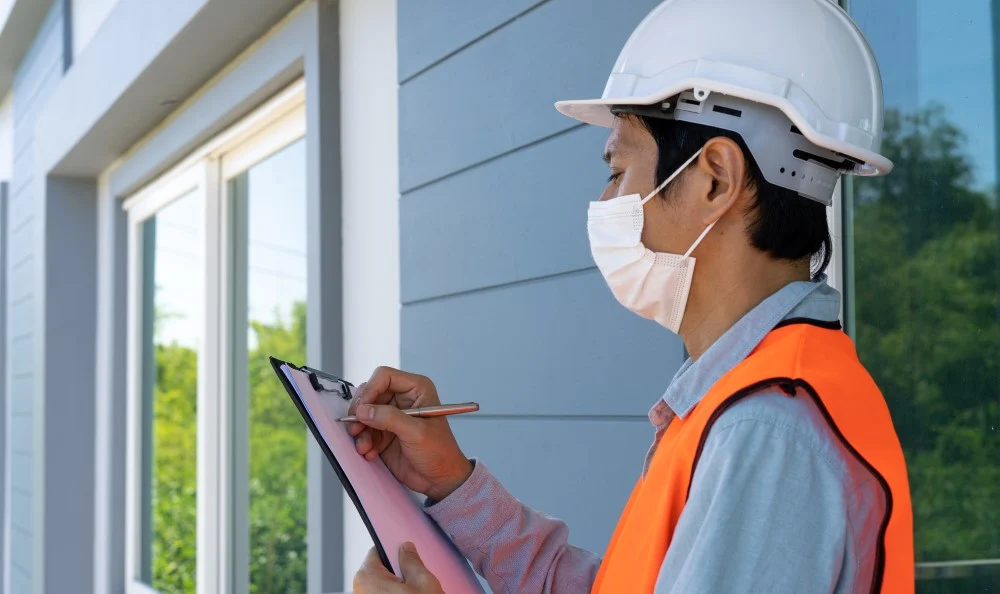
Your existing roof structure determines which materials work without expensive modifications. Slate tiles and clay tiles need reinforced framing to support their weight. Switching from lightweight asphalt shingles to heavy tile roofing often requires engineering evaluation and structural upgrades. On the other hand, metal shingles or rubber roof materials are installed on standard framing.
Roofing Material Warranties and Protection
Manufacturer warranties vary dramatically between roofing types and brands. Basic three-tab shingles may offer 20-year coverage, while premium architectural shingles may offer 50-year coverage. Standing seam metal roofing often carries 30 to 40-year paint warranties, plus 50-year material guarantees. Always read warranty terms carefully, as most require professional installation and regular maintenance to remain valid.
Professional Installation and Maintenance
Expert installation maximizes the performance and longevity of any roofing system. Certified roofing contractors understand manufacturer specifications, local building codes, and proper installation techniques. They spot potential problems with your roof deck before they become expensive repairs. For the best results, we recommend scheduling installations during favorable weather.








